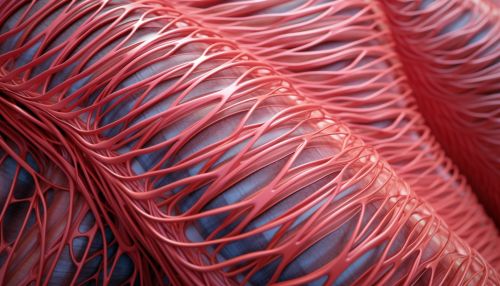Myocardium
Anatomy and Structure
The myocardium is the middle layer of the heart wall and is composed of cardiac muscle tissue. This layer is responsible for the heart's ability to contract and thus pump blood throughout the body. The myocardium is sandwiched between two protective layers: the epicardium on the outside and the endocardium on the inside read more.
The cardiac muscle cells, or cardiomyocytes, that make up the myocardium are unique in their structure and function. Unlike skeletal muscle cells, cardiomyocytes are connected to each other by intercalated discs, which allow for the rapid transmission of electrical signals across the myocardium. This coordinated electrical activity is what allows the heart to contract as a single unit, or syncytium read more.
Physiology
The primary function of the myocardium is to contract and force blood out of the heart and into the circulatory system. This process, known as myocardial contraction, is regulated by the autonomic nervous system and is influenced by various factors including heart rate, blood pressure, and oxygen levels in the blood read more.
The myocardium also plays a critical role in maintaining the heart's electrical stability. The cells of the myocardium are capable of generating and conducting electrical impulses, which are essential for the coordinated contraction of the heart muscle. This electrical activity can be measured and visualized using an electrocardiogram (ECG) read more.
Pathology
Various diseases and conditions can affect the myocardium, leading to impaired heart function. Myocardial infarction, commonly known as a heart attack, is a condition in which a portion of the myocardium dies due to a lack of oxygen. This is typically caused by a blockage in one of the coronary arteries, which supply blood to the myocardium read more.
Other conditions that can affect the myocardium include myocarditis (inflammation of the myocardium), cardiomyopathy (disease of the heart muscle), and heart failure (a condition in which the heart is unable to pump enough blood to meet the body's needs) read more read more read more.


